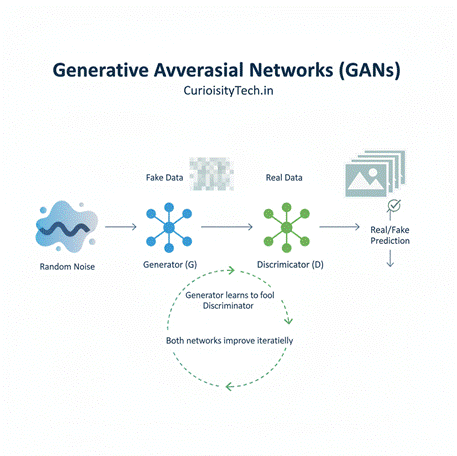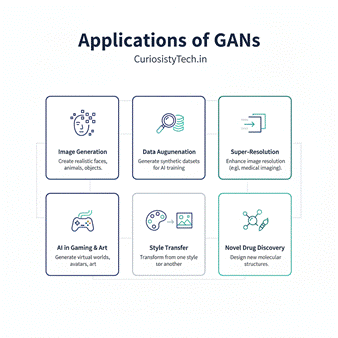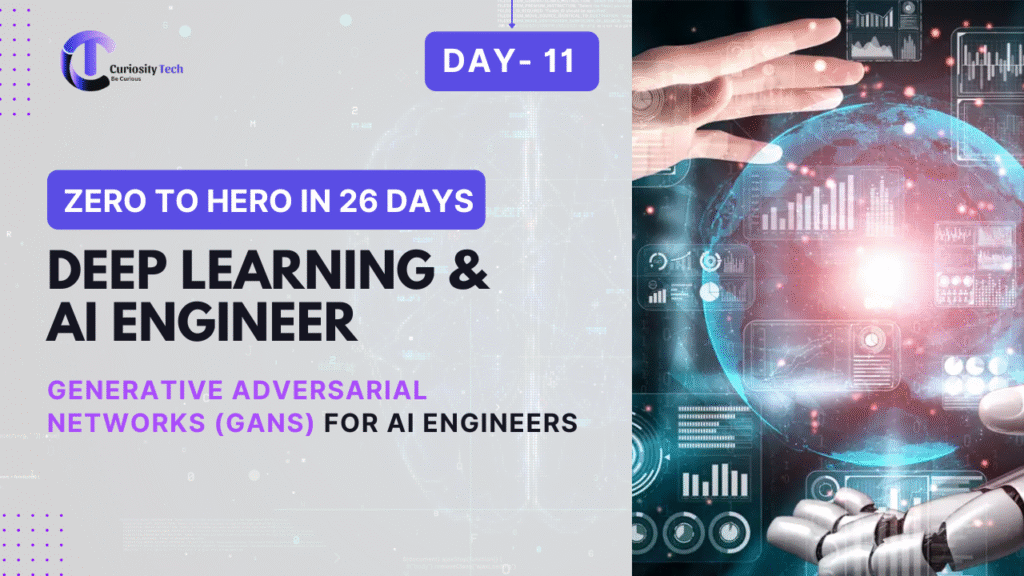Introduction
Generative Adversarial Networks (GANs) are among the most exciting breakthroughs in AI. Introduced by Ian Goodfellow in 2014, GANs allow machines to generate realistic data, including images, music, and even synthetic datasets for training other AI models.
At CuriosityTech.in, learners in Nagpur experiment with GANs for projects like image generation, style transfer, and data augmentation, gaining hands-on experience that bridges research and practical application.
1. What is a GAN?
A GAN is a type of neural network architecture consisting of two competing networks:
- Generator (G): Creates fake data to mimic real data
- Discriminator (D): Evaluates whether the data is real or fake
Conceptual Diagram (Textual Representation):
Random Noise → Generator → Fake Data → Discriminator → Real/Fake
Real Data → Discriminator → Real/Fake
Generator learns to fool Discriminator → Both networks improve iteratively

Analogy: Think of a forger and an art critic. The forger tries to create realistic paintings, while the critic tries to detect fakes. Over time, both improve.
2. How GANs Work
Step 1 – Generator
- Takes random noise vector as input
- Outputs synthetic data (e.g., an image)
Step 2 – Discriminator
- Takes real and generated data as input
- Outputs probability of data being real
Step 3 – Training
- Discriminator loss: Maximize ability to distinguish real vs fake
- Generator loss: Minimize Discriminator’s ability to detect fakes
Mathematical Formulation:
minGmaxDV(D,G)=Ex∼pdata(x)[logD(x)]+Ez∼pz(z)[log(1−D(G(z)))]\min_G \max_D V(D, G) = \mathbb{E}_{x\sim p_{data}(x)}[\log D(x)] + \mathbb{E}_{z\sim p_z(z)}[\log(1-D(G(z)))]GminDmaxV(D,G)=Ex∼pdata(x)[logD(x)]+Ez∼pz(z)[log(1−D(G(z)))]
- G = Generator
- D = Discriminator
- x = real data
- z = random noise
3. Types of GANs
| Type | Description | Applications |
| Vanilla GAN | Original architecture | Image generation |
| DCGAN | Deep Convolutional GAN | High-quality images |
| Conditional GAN | Generate data based on labels | Image-to-image translation |
| CycleGAN | Style transfer without paired data | Convert horse → zebra images |
| StyleGAN | Photorealistic human faces | Face generation, gaming avatars |
CuriosityTech Insight: Beginners start with DCGANs for image generation projects, then advance to StyleGANs for high-quality outputs.
4. Practical Project Example
Objective: Generate handwritten digits using DCGAN on MNIST dataset
Step 1 – Generator
- Input: Random noise
- Layers: Dense → Reshape → Conv2DTranspose → Activation (ReLU)
Step 2 – Discriminator
- Input: Real and generated images
- Layers: Conv2D → Flatten → Dense → Activation (Sigmoid)
Training Loop:
- Generate fake images
- Train Discriminator on real and fake images
- Train Generator to fool Discriminator
Observation: Students at CuriosityTech see generated digits gradually improving, demonstrating iterative adversarial learning in action.
5. Applications of GANs

- Image Generation: Create realistic human faces, animals, or objects
- Data Augmentation: Generate synthetic datasets for AI training
- Super-Resolution: Enhance image resolution for medical imaging
- Style Transfer: Transform images from one style to another
- AI in Gaming & Art: Generate virtual worlds, avatars, and creative content
6. Challenges of GANs
- Mode Collapse: Generator produces limited variety of outputs
- Training Instability: Difficult to balance Generator and Discriminator
- High Computational Requirements: Especially for high-resolution images
CuriosityTech Tip: Mentors teach strategies to stabilize training, such as learning rate tuning, batch normalization, and Wasserstein GAN (WGAN).
7. Career Relevance
- AI engineers specializing in generative AI are in high demand
- GANs are critical for computer vision, creative AI, and synthetic data generation
- Employers expect practical experience in:
- DCGAN, StyleGAN, Conditional GAN
- Training stability and evaluation
- Real-world deployment
- DCGAN, StyleGAN, Conditional GAN
Portfolio Tip: At CuriosityTech.in, learners create GAN-based projects, like generating handwritten digits or photorealistic avatars, which stand out to recruiters.
8. Human Story
A student at CuriosityTech initially tried generating animal images using a Vanilla GAN but got unrealistic outputs. After switching to a DCGAN and tuning layers, the generated images became recognizable. The project taught the importance of experimentation and understanding GAN architecture, key skills for a career in generative AI.
Conclusion
Generative Adversarial Networks are transforming AI applications across art, media, and research. For aspiring AI engineers, mastering GANs is essential for career growth in 2025. Platforms like CuriosityTech.in provide hands-on guidance, project mentorship, and real-world application experience, enabling students to build a robust portfolio in generative AI.


